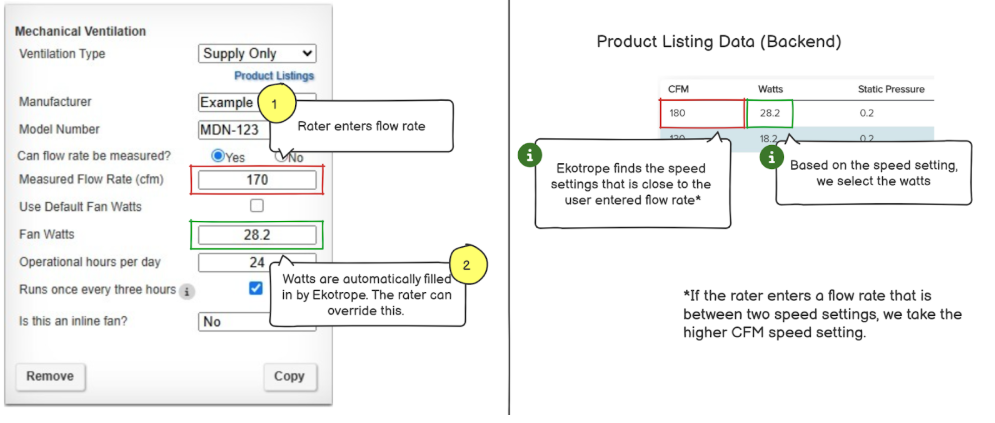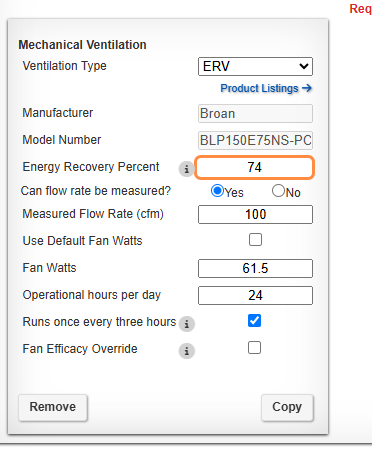Overview
Product Listings provide a streamlined and accurate way to model Mechanical Ventilation in Ekotrope. Instead of manually scouring the internet for the relevant performance details for the equipment you are trying to model, performance details are available directly in Ekotrope, along with links to relevant spec sheets and performance databases like Home Ventilating Institute (HVI.org). Additionally, we provide handy tools to accurately model things like fan wattage and recovery percent for various types of systems.
How It Works
When modeling mechanical ventilation, you can view a list of equipment for which we have a Product Listing in Ekotrope. For each piece of equipment, we show a summary of its performance characteristics, like the range of CFM the equipment can provide. More detailed performance information is available by clicking “Learn more” for any product listing.
You can “Apply” your product listing to the mechanical ventilation system you are modeling. When you click apply, Ekotrope will fill in certain fields with accurate information from the manufacturer. However, we leave the entries blank that are tied to field installation and diagnostic testing. The Rater must still verify and confirm the correct information for these features.

Fan Watts, Airflow, and Energy Recovery Percent
When you “Apply” a product listing, Ekotrope will fill in certain fields, such as Fan Watts and Energy Recovery Percent (If the system is an ERV/HRV).
The fan watts and recovery percent are calculated differently based on whether the equipment has discrete speed settings or a variable speed setting. In both cases, the Rater enters a flow rate, and we use the data in the Product Listing to estimate Fan Watts and Energy Recovery Percent. Note: This approach aligns with common User practices, but it may not be right in every case. Therefore, the Rater can always override the information auto-populated by Product Listings where appropriate for the home.
Systems with discrete speed settings

Systems with variable speeds

ERVs/HRVs with discrete speed settings

Input Outlines
You will notice inputs may have green or orange outlines at different times. The green outline indicates afield that will be automatically filled when you select a product listing, and an orange outline indicates that the value of that input has been overridden and does not match what was supplied by the product listing. While the green outline is temporary, the orange outline will persist as a warning.
Example: The orange outline appears here, when a user overrides the Energy Recovery Percent and it no longer matches the default value provided by the product listing.

“Apply” details for each type of ventilation equipment
Below is a breakdown of the changes Ekotrope makes to the Mechanical Ventilation inputs when the Rater applies a product listing, broken down by Ventilation Type:
Ventilation Types: Exhaust Only, Supply Only, Balanced
Ekotrope Field | Summary | Details |
Ventilation Type | Manufacturer Supplied |
|
Manufacturer | Manufacturer Supplied |
|
Model Number | Manufacturer Supplied |
|
Can flow rate be measured? | Entered by the User |
|
Measured Flow Rate (cfm) | Entered by the User | |
Use Default Fan Watts | Unchecked | Unchecked to use the watts provided by the Product Listing. |
Fan Watts | Manufacturer Supplied
For Exhaust-only systems, we reference wattage based on CFM at .25 Inches of Water Gauge (in w.g.) static pressure. For all other ventilation types, we reference wattage based on CFM at 0.2 (in w.g.) static pressure
Checked for alignment with published HVI data if the product is registered. Otherwise, based on manufacturer's Spec Sheets | If the system has discrete speed settings:
We choose the watts based on the speed setting with a CFM at 0.2 (in w.g.) static pressure (or .25 for exhaust-only systems) which is greater than or equal to the Rater-entered CFM.
The reason we take the tested point with a greater CFM, as opposed to the tested point with the closest CFM, is because we think that in the field, static pressure is more likely to be higher than 0.2 (in w.g.) then it is to be lower than 0.2 (in w.g.).
For example, if there is a system with two speed settings - high and low - which move 80 CFM and 100 CFM respectively at 0.2 (in w.g.) static pressure, and the Rater measures 90 CFM, Ekotrope determines that the most likely system setting is 100 CFM, and that a higher static pressure in the field accounts for the 10 CFM degradation from the tested value. In this situation, we set the Fan Watts to the wattage corresponding to the higher, 100 CFM speed setting.
If the system does not have discrete speed settings:
We interpolate wattage based on the rater entered CFM, and the performance of the ventilation equipment tested at multiple CFMs.
If the rater enters a CFM between two tested values, we use linear interpolation to estimate the fan watts at the CFM which the user entered. For example, say a system is tested and draws 20 watts at 100 CFM, and 40 watts at 200 CFM. If the rater enters a CFM of 150, we estimate the fan watts to be 30.
If the rater enters a CFM which is below the lowest tested CFM, we use the wattage at the lowest tested CFM. Likewise, if the rater enters a CFM which is more than the greatest tested CFM, we use the wattage at the greatest tested CFM. |
Operational Hours per Day | Entered by the User |
|
Runs once every three hours | Entered by the User |
|
Is this an Inline Fan? | Manufacturer Supplied |
|
Ventilation Types: HRV / ERV
Ekotrope Field | Summary | Details |
Ventilation Type | Manufacturer Supplied |
|
Manufacturer | Manufacturer Supplied |
|
Model Number | Manufacturer Supplied |
|
Energy Recovery Percent | Manufacturer Supplied
We reference energy recovery percent - based on CFM at 0.2 (in w.g.) static pressure and 32 degrees fahrenheit.
Checked for alignment with published HVI data if the product is registered. Otherwise, based on manufacturer's Spec Sheets | We interpolate Energy Recovery Percent based on the rater entered CFM, and the performance of the ventilation equipment tested at multiple CFMs.
If the rater enters a CFM between two tested values, we use linear interpolation to estimate the energy recovery percent at the CFM which the user entered. For example, say a system is tested and has an ASRE of 80 at 100 CFM, and 60 at 200 CFM. If the rater enters a CFM of 150, we estimate the recovery efficiency to be 70.
If the rater enters a CFM which is below the lowest tested CFM, we use the recovery efficiency at the lowest tested CFM. Likewise, if the rater enters a CFM which is more than the greatest tested CFM, we use the recovery efficiency at the greatest tested CFM.
|
Can flow rate be measured? | Entered by the User |
|
Measured Flow Rate (cfm) | Entered by the User | |
Use Default Fan Watts | Unchecked | We presume that the Rater user will not use default watts.
The Rater can choose to use Default Fan Watts after they select the Product Listing if they choose.
|
Fan Watts | Manufacturer Supplied
We reference wattage based on CFM at 0.2 (in w.g.) static pressure.
Checked for alignment with published HVI data if the product is registered. Otherwise, based on manufacturer's Spec Sheets | Follows same Fan Watts logic as described in Exhaust Only, Supply Only, and Balanced Section
|
Operational Hours per Day | Entered by the User |
|
Fan Efficacy Exemption | Entered by the User |
|
Ventilation Type: Air Cycler (CFIS)
Ekotrope Field | Summary | Details |
Ventilation Type | Manufacturer Supplied |
|
Manufacturer | Manufacturer Supplied |
|
Model Number | Manufacturer Supplied |
|
Fan Motor Type | Entered by the User | In the case of CFIS systems, the fan type will be that of the main HVAC system’s blower fan. Please reference Modeling Central Fan Integrated Supply (CFIS) systems for mechanical ventilation for more information. |
Can flow rate be measured? | Entered by the User |
|
Measured Flow Rate (cfm) | Entered by the User | |
Use Default Fan Watts | Unchecked | We presume that the Rater user will not use the default watts.
The Rater can choose to use Default Fan Watts after they select the Product Listing if they choose.
|
Fan Watts | Entered by the User | In the case of CFIS systems, the wattage will typically be that of the main HVAC system’s blower fan. Reference Modeling Central Fan Integrated Supply (CFIS) systems for mechanical ventilation for more information. |
Operational Hours per Day | Entered by the User |
|
Runs once every three hours | Entered by the User |
|
Distribution System Assigned | Entered by the User |
|
Has automatic flow control of outdoor air? | Manufacturer Supplied |
|
Blower fan control strategy | Manufacturer Supplied |
|
Has a strategy to meet the ventilation remainder? | Manufacturer Supplied |
|
Ventilation Type: Air Cycler with Supplemental Fan (CFIS)
Ekotrope Field | Summary | Details |
Ventilation Type | Manufacturer Supplied |
|
Manufacturer | Manufacturer Supplied |
|
Model Number | Manufacturer Supplied |
|
Can flow rate be measured? | Entered by the User |
|
Measured Flow Rate (cfm) | Entered by the User | |
Use Default Fan Watts | Unchecked | We presume that the Rater user will not use default watts.
The Rater can choose to use Default Fan Watts after they select the Product Listing if they choose.
|
Fan Watts | Manufacturer Supplied Or Entered by the User | Depends on the details of the system. If the model(s) in the Product Listing includes a supplemental fan, the Manufacturer will supply information about the Fan to allow us to enter Fan Watts according to the logic for that type of fan (see information for other fan types). |
Operational Hours per Day | Entered by the User | |
Runs once every three hours | Entered by the User |
|
Is this an inline fan? | Manufacturer Supplied Or Entered by the User | Depends on the details of the system. If the model(s) in the Product Listing includes a supplemental fan, the Manufacturer will supply their recommended input for this field. Otherwise, the user will need to enter this info.. |
Distribution System Assigned | Entered by the User |
|
Has automatic flow control of outdoor air? | Manufacturer Supplied | The Manufacturer will supply their recommended input for this field based on their spec sheets. |
Supplemental Fan Type | Manufacturer Supplied
Or
Entered by the User | Depends on the details of the system. If the model(s) in the Product Listing includes a supplemental fan, the Manufacturer will supply their recommended input for this field. Otherwise, the user will need to enter this info. |
Does supplemental fan run simultaneously with blower fan? | Manufacturer Supplied
| Depends on the details of the system. The Manufacturer will supply their recommended input for this field based on the product’s documented configuration options. The system should be checked to make sure that the setting matches the assumption. |




